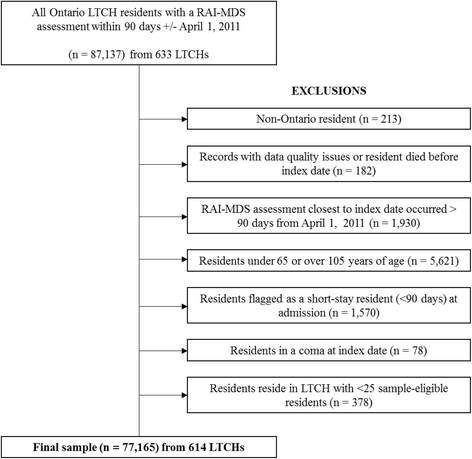Disability in long-term care residents explained by prevalent geriatric syndromes, not long-term care home characteristics: a cross-sectional study
- PMID: 28183274
- PMCID: PMC5301427
- DOI: 10.1186/s12877-017-0444-1
Disability in long-term care residents explained by prevalent geriatric syndromes, not long-term care home characteristics: a cross-sectional study
Abstract
Background: Self-care disability is dependence on others to conduct activities of daily living, such as bathing, eating and dressing. Among long-term care residents, self-care disability lowers quality of life and increases health care costs. Understanding the correlates of self-care disability in this population is critical to guide clinical care and ongoing research in Geriatrics. This study examines which resident geriatric syndromes and chronic conditions are associated with residents' self-care disability and whether these relationships vary across strata of age, sex and cognitive status. It also describes the proportion of variance in residents' self-care disability that is explained by residents' geriatric syndromes versus long-term care home characteristics.
Methods: We conducted a cross-sectional study using a health administrative cohort of 77,165 long-term care home residents residing in 614 Ontario long-term care homes. Eligible residents had their self-care disability assessed using the RAI-MDS 2.0 activities of daily living long-form score (range: 0-28) within 90 days of April 1st, 2011. Hierarchical multivariable regression models with random effects for long-term care homes were used to estimate the association between self-care disability and resident geriatric syndromes, chronic conditions and long-term care home characteristics. Differences in findings across strata of sex, age and cognitive status (cognitively intact versus cognitively impaired) were examined.
Results: Geriatric syndromes were much more strongly associated with self-care disability than chronic conditions in multivariable models. The direction and size of some of these effects were different for cognitively impaired versus cognitively intact residents. Residents' geriatric syndromes explained 50% of the variation in their self-care disability scores, while characteristics of long-term care homes explained an additional 2% of variation.
Conclusion: Differences in long-term care residents' self-care disability are largely explained by prevalent geriatric syndromes. After adjusting for resident characteristics, there is little variation in self-care disability associated with long-term care home characteristics. This suggests that residents' geriatric syndromes-not the homes in which they live-may be the appropriate target of interventions to reduce self-care disability, and that such interventions may need to differ for cognitively impaired versus unimpaired residents.
Keywords: Activities of daily living; Chronic disease; Disability; Disablement Process; Geriatric syndrome; Nursing homes.
Figures
Similar articles
-
Long-Term Care Residents' Geriatric Syndromes at Admission and Disablement Over Time: An Observational Cohort Study.J Gerontol A Biol Sci Med Sci. 2019 May 16;74(6):917-923. doi: 10.1093/gerona/gly151. J Gerontol A Biol Sci Med Sci. 2019. PMID: 29955879 Free PMC article.
-
The effect on nursing home resident outcomes of creating a household within a traditional structure.J Am Med Dir Assoc. 2013 Apr;14(4):293-9. doi: 10.1016/j.jamda.2013.01.013. Epub 2013 Feb 22. J Am Med Dir Assoc. 2013. PMID: 23434319
-
A Capabilities Approach to Environmental Impact on Nursing Home Resident Quality of Life.Res Gerontol Nurs. 2017 Jul 1;10(4):162-170. doi: 10.3928/19404921-20170621-03. Res Gerontol Nurs. 2017. PMID: 28742925
-
Attitudes and needs of residents in long-term care facilities regarding physical activity-A systematic review and synthesis of qualitative studies.J Clin Nurs. 2019 Jul;28(13-14):2386-2400. doi: 10.1111/jocn.14761. Epub 2019 Jan 15. J Clin Nurs. 2019. PMID: 30589972
-
Descriptive Epidemiology of Chronic Obstructive Pulmonary Disease in US Nursing Home Residents With Heart Failure.Curr Probl Cardiol. 2023 Feb;48(2):101484. doi: 10.1016/j.cpcardiol.2022.101484. Epub 2022 Nov 4. Curr Probl Cardiol. 2023. PMID: 36343840 Free PMC article. Review.
Cited by
-
Barriers and facilitators to providing rehabilitation for long-term care residents with dementia: a qualitative study.BMC Geriatr. 2024 Oct 15;24(1):838. doi: 10.1186/s12877-024-05433-z. BMC Geriatr. 2024. PMID: 39407157 Free PMC article.
-
Effectiveness of physical rehabilitation in improving physical functioning and quality of life for long-term-care residents with dementia: a systematic review protocol.JBI Evid Synth. 2023 Jan 1;21(1):207-213. doi: 10.11124/JBIES-22-00096. JBI Evid Synth. 2023. PMID: 36036561 Free PMC article.
-
Sarcopenia is associated with mortality in non-critical elderly patients visiting the emergency department.Front Med (Lausanne). 2023 Jan 11;9:1027503. doi: 10.3389/fmed.2022.1027503. eCollection 2022. Front Med (Lausanne). 2023. PMID: 36714126 Free PMC article.
-
A qualitative exploration of Chinese rural older adults' adaption experience to disability in Henan Province.BMC Public Health. 2023 Mar 17;23(1):512. doi: 10.1186/s12889-023-15425-0. BMC Public Health. 2023. PMID: 36927448 Free PMC article.
-
Dementia Moves: protocol for a feasibility study testing a physical rehabilitation program for long-term care residents with moderate to severe dementia.Pilot Feasibility Stud. 2025 Jul 26;11(1):104. doi: 10.1186/s40814-025-01685-7. Pilot Feasibility Stud. 2025. PMID: 40713920 Free PMC article.
References
-
- Canadian Institute for Health Information. When a nursing home is home: how do Canadian nursing homes measure up on quality. Toronto: Canadian Institute of Health Information 2013. https://secure.cihi.ca/free_products/CCRS_QualityinLongTermCare_EN.pdf. Accessed 12 Oct 2016.
-
- Dutcher SK, Rattinger GB, Langenberg P, Chhabra PT, Liu X, Rosenberg PB, Leoutsakos JM, Simoni-Wastila L, Walker LD, Franey CS, et al. Effect of medications on physical function and cognition in nursing home residents with dementia. J Am Geriatr Soc. 2014;62(6):1046–1055. doi: 10.1111/jgs.12838. - DOI - PMC - PubMed
MeSH terms
Grants and funding
LinkOut - more resources
Full Text Sources
Other Literature Sources
Medical
Research Materials
Miscellaneous


